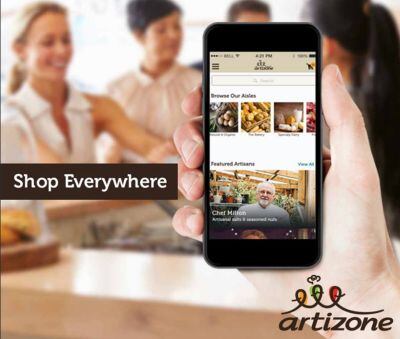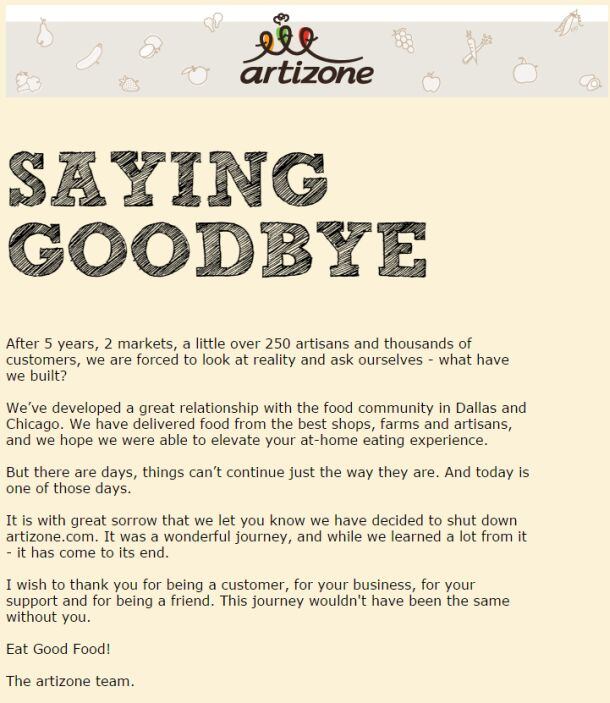Cash-flow, says co-founder and COO Lior Lavy, who says Artizone depended heavily on earnings from a software business he ran in Israel, which had just lost a major client.
He told FoodNavigatior-USA: “We ran out of money. We spent November to January trying to raise money but it was really impossible to get it in such a short space of time. We were pretty honest about our situation, and we told investors that unless we were able to close a deal really fast, we would be forced to shut down... I’m pretty sure that if we had the ability to have longer discussions and follow-up meetings with more questions, answers and data, we could have landed a deal."
Asked how much money he was seeking for Artizone - which launched in Dallas in 2011 and expanded to Chicago in 2012 - he said: "We had two plans - a super-lean one and a more realistic one - that spanned between $3M - $5M. We believed that with this amount of money we could have brought [the Artizone operation in] Dallas to profitability, while keeping Chicago below break-even point within a year. Our plan was to then raise a second round, based on a success in Dallas, to open 10 more markets."
He added: “Day after day with Artizone we’ve seen nothing but growth over the past 18 months, but we’re not at breakeven and we couldn’t keep going. There was interest [from potential investors] but we just needed more time.”
A viable business model?
Asked whether Artizone had a viable business model (see box below), he said: "Definitely. We had an operational model that proved delivery costs - all in - that are way below anything we know from the industry.
"With our costs, being able to break even was only a matter of reaching 200 orders a day. Given that an average customer places an order every two weeks, what you really need is around 3,000 repeat customers (which is absolutely achievable given you have the funds to market). We were roughly 33% down the path to profitability, and we were able to reach that point with a very limited investment in marketing, which is what we needed the extra money for.
"Around 85% of our weekly orders came from repeat customers, and around 45% of 'first timers' became repeat customers. We also kept costs down because we weren’t holding inventory or picking orders, just delivering them.”

Artizone - which launched in Dallas in 2011, expanded to Chicago in 2012 and moved into Denver in 2015 - offered early stage food and beverage startups a convenient way to market, sell and distribute within their locality, while preserving their independence.
The online platform helped small food producers - primarily those selling perishable goods (bakery, produce, fish, meat, dairy) - reach more consumers than they would with a single online storefront by gathering their products on virtual grocery store shelves that leveraged their collective appeal to consumers looking for a more convenient way to shop locally.
But unlike traditional retailers that buy products and resell them at a markup, Artizone “steps aside to let the artisans do the job” of filling the orders they receive from consumers through Artizone, said founder and COO Lior Lavy.
Artizone then collected and delivered the products to consumers so producers could focus on filling orders rather than on the complicated logistics of delivering them, he said. Artizone in turn made a commission per transaction.
This model allowed producers to control consumers’ experience with their brand, manage the quality of their products without the risk of spoilage at a holding facility, and create direct relationships with consumers, Lavy explained.
How it worked
"Consumers were able to place an order from as many vendors they wanted by 12pm and get home-delivery the same evening. There were a few exceptions, however, for instance businesses that baked-to-order and required a longer lead time.
"We had roughly 220 active artisans and businesses on the platform."
As for the basket size, it varied, he said: "We had groups of customers that spent way over $150. First time orders were usually smaller. And we had groups of elderly that placed smaller orders on a more frequent basis."
Asked about growth, he said: "2014 was an amazing growth year in Chicago, while Dallas was relatively flat. We then made a few changes in Dallas that got it off to a great growth. This is the time to mention Amber Dietric [VP market operations], who was leading these changes and growth while showing dedication, professionalism and excellence in every move. A part of our plan was to duplicate these changes to Chicago."
So what’s next?
Right now, Lavy claims he could still resurrect the business if he were able to secure $3-5m.
He added: “It’s definitely not too late. The reality is that we had to let artisans, shops and customers that we’re no longer in business, but from the reactions we’ve received, many would love to see us restarting. We may be starting from a slightly pushed-back position, but we know how to go forward."
Read more about Artizone HERE.
Read the message on Artizone's website below:

